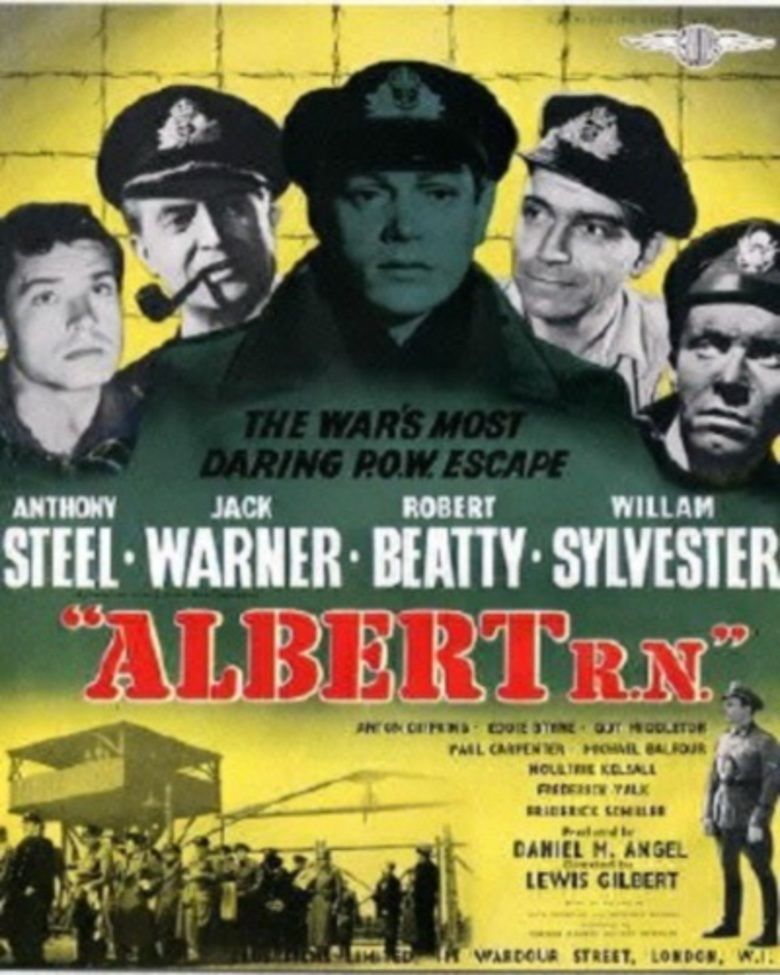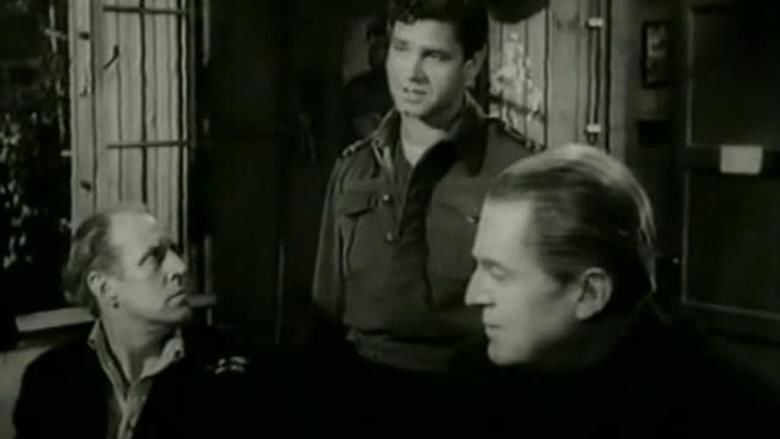Albert RN
7 /10 1 Votes7
Duration Country United Kingdom | 6.8/10 IMDb Language English | |||||||||||||||||||||||||||||||||
 | ||||||||||||||||||||||||||||||||||
Release date 1953 Based on play by Guy Morgan and Edward Sammis Tagline The War's Most Daring P.O.W. Escape | ||||||||||||||||||||||||||||||||||
Albert R.N. is a 1953 British war film directed by Lewis Gilbert and starring Anthony Steel.
Contents

Plot
The escape tunnel for the Allied prisoners at a German prisoner-of-war camp for naval officers is discovered.
Lieutenant Ainsworth devises a scheme with the escape committee to use a dissembled mannequin named Albert to convince the Germans that all prisoners sent outside the camp for a bathhouse wash up are returned to the camp. A piece of Albert is smuggled with the prisoners going to the bathhouse and reassembled for the return. Ainsworth also has a woman pen pal he has never seen; he plans to marry her once he is free. Though the originator has the right to try out his own idea, Ainsworth insists that his hut mates draw cards for the privilege; Erickson wins and gets away.
After waiting a while, they decide to reuse the ploy. This time, Ainsworth's friend, after hearing that his pen pal has not written in a while, sees to it that the draw is rigged so that he wins. Ainsworth, however, auctions off his place, only to have Captain Maddox, the senior prisoner of war, order him to go. Ainsworth is recaptured the same day.
Later, the camp commandant informs the men that Erickson was shot while resisting arrest by the Gestapo; his ashes are handed over.
When SS Hauptsturmführer Schultz expresses interest in American Lieutenant "Texas" Norton's chronometer, Norton notes Schultz is in charge of the camp's boundary lights and asks him to see that they malfunction during the next Allied nighttime bombing raid. However, it is a trap. Schultz signals his men to turn the lights back on while Norton is cutting thought the barbed wire fence, then shoots him down in cold blood.
Schultz tries to suborn Ainsworth, but Ainsworth tells him he will see to it he is prosecuted for murder after the war. When Schultz becomes the new kommandant, Ainsworth insists on trying to escape again, using Albert. He gets away, but waits at night to confront Schultz outside the camp. After a struggle, he gets Schultz's pistol. When Allied bombs drop uncomfortably close by, Schultz runs for it. Ainsworth is unable to bring himself to shoot the fleeing German in the back, but a bomb kills him. Ainsworth takes back Norton's chronometer from the dead man and walks away.
Historical background
The film is based on a true story. "Albert R.N." was a dummy constructed in Marlag O, the prisoner of war camp in northern Germany for naval officers. The head was sculpted by war artist John Worsley (1919–2000), the body by Lieutenant Bob Staines RNVR, and Lieutenant-Commander Tony Bentley-Buckle devised a mechanism enabling Albert’s eyes to blink and move, adding realism to the dummy. "Albert" was used as a stand-in for a head count while a prisoner escaped and was used on two separate occasions. In the first attempt Lieutenant William "Blondie" Mewes RNVR escaped from the camp shower block, and the skilfull use of "Albert" during roll-calls gave him four days head start before a missing PoW was reported. Unfortunately, Mewes was recaptured in Lübeck and returned to Marlag camp. The second occasion was unsuccessful, when the escaping PoW was discovered hiding in the camp shower block and "Albert" was discovered in the subsequent searches.
Worsley made a new "Albert" for use in the film. Senior Commissioned Gunner (TAS) Lieut. John William Goble RN. aided Worsley in the development of "Albert" in the POW camp, Marlag O and acted as technical adviser for the film. Worsely made a third "Albert" for the retrospective exhibition of his work held in Brighton College's Burstow Gallery. After the show, it was donated to the Royal Naval Museum Portsmouth.
Guy Morgan and Edward Sammis, who were British POWs, wrote a play based on the story on which this film was based. This was subsequently adapted into a screenplay.
Production
Anthony Steel and Jack Warner were both lent to producer Daniel Angel by the Rank Organisation. Both had previously appeared in POW movies, The Wooden Horse (1950) and The Captive Heart (1946) respectively.
A POW camp was built on Headingley Heath.
At one stage the film was going to be called The Spare Man.
Release
Lewis Gilbert says the film earned its money back in the United Kingdom.
References
Albert R.N. WikipediaAlbert RN IMDb Albert RN themoviedb.org
